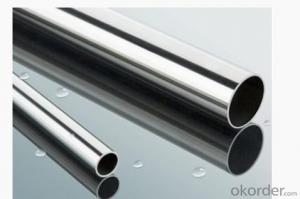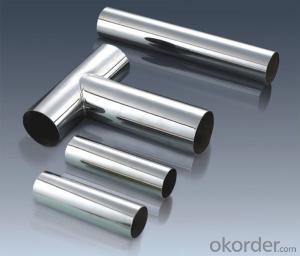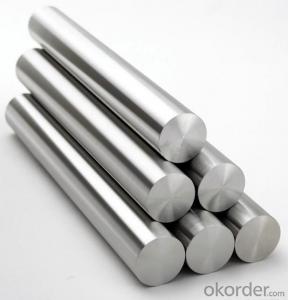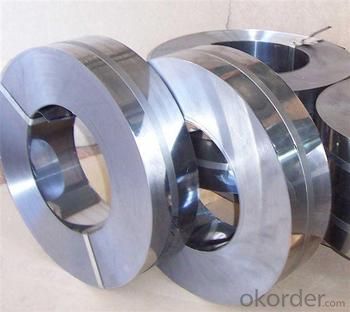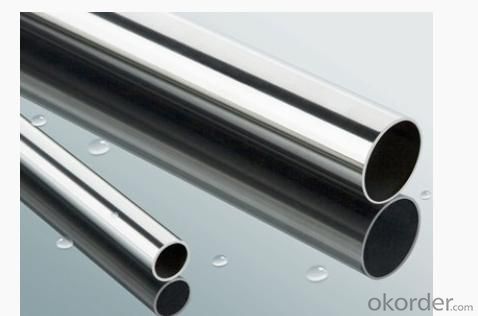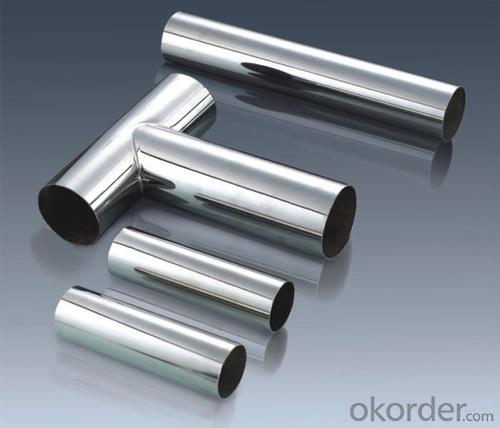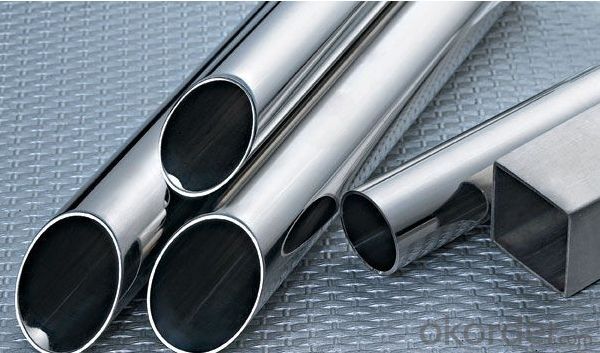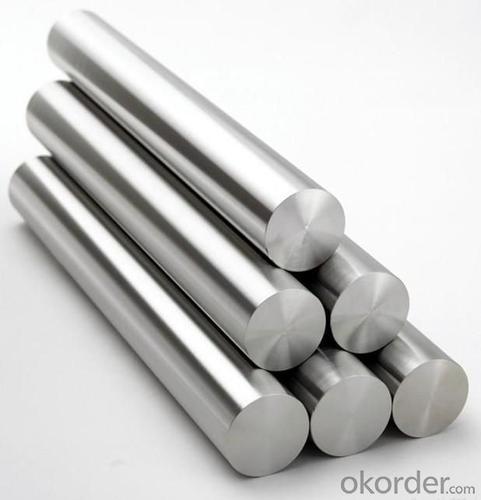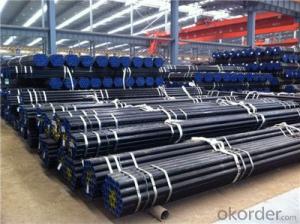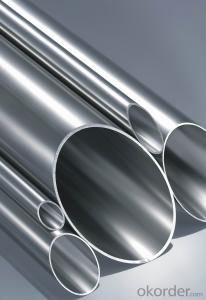Stainless Steel tube 304 raw material best quality
- Loading Port:
- Shanghai
- Payment Terms:
- TT OR LC
- Min Order Qty:
- 1000 m.t
- Supply Capability:
- 1000000 m.t/month
OKorder Service Pledge
OKorder Financial Service
You Might Also Like
Stainless steel 304
Product Information of stainless steel:
- Width: customized
- Surface: 2B/BA/6K/8K/NO.4/HL.
- Thickness: 0.3mm - 3.0mm.
- Delivery time: 15-25 days.
- Length : As customer's requirement.
- Package: With export standard packing or customize packing.
- Payment Terms: T/T (30% deposit pay in advance and the balance before shipment) , irrevocable L/C.
Company advantage:
-Top Equipments, Leading In The Industry.
- Professional Team, Leading Innovation.
- Huge Supply Capacity Advantage, Timely and Effective Delivery.
- Modern Logistic, Fact and Convenient.
- Precise Manufacturing, Exquisite Products.
- Serve People, Create Value.
- Dimensional Network, Powerful Expansion.

- Q: Can stainless steel pipes be used for dairy industries?
- Yes, stainless steel pipes can be used for dairy industries. Stainless steel is a highly durable and corrosion-resistant material, making it suitable for the sanitary requirements of the dairy industry. It is widely used in the production, processing, and transportation of milk and other dairy products due to its hygienic properties and ease of cleaning.
- Q: Can stainless steel pipes be used for pulp and paper industries?
- Stainless steel pipes are indeed applicable for use in the pulp and paper sectors. Due to their remarkable resistance against corrosion and abrasion, these pipes are well-suited for the tough and corrosive environments commonly found in pulp and paper mills. They are capable of enduring the corrosive chemicals and high temperatures associated with the production process, ensuring the piping system's longevity and reliability. Moreover, stainless steel pipes possess exceptional mechanical properties, such as high tensile strength and resistance to stress corrosion cracking. These qualities are crucial for the efficient transportation of fluids and gases within the pulp and paper industry. Overall, stainless steel pipes provide a durable, hygienic, and cost-effective solution for fulfilling piping requirements in the pulp and paper sectors.
- Q: What are the specifications for stainless steel pipes?
- The specifications for stainless steel pipes typically include the material grade, dimensions (such as outer diameter, wall thickness, and length), and specific standards or certifications they adhere to, such as ASTM, ASME, or EN. Additionally, specifications may also include information about the surface finish, type of joint or connection, and any special requirements for corrosion resistance or mechanical properties.
- Q: Can stainless steel pipes be insulated with polycaprolactone?
- Insulating stainless steel pipes with polycaprolactone is indeed possible. Known as PCL, polycaprolactone is a thermoplastic polymer with superb thermal insulation properties. With its low thermal conductivity, it effectively insulates pipes, preventing heat loss or gain. Moreover, PCL is resistant to moisture and chemicals, making it suitable for different environments and applications. By applying polycaprolactone as insulation on stainless steel pipes, one can achieve the desired temperature, decrease energy consumption, and avoid condensation.
- Q: Stainless steel pipe chamfering how to process?
- If the amount of larger or longer steel pipe, you can buy a dedicated handheld steel pipe chamfering tool, called "steel chamfering machine"". This is much more efficient than using a lathe.
- Q: Stainless steel why rust?
- Stainless steel surface adhesion of organic juice (such as vegetables, soup, sputum), oxygen in the water under the circumstances, a long time, organic acid, organic acid on the surface of metal corrosion.
- Q: How do stainless steel pipes compare to aluminum pipes?
- Stainless steel pipes have superior durability and corrosion resistance compared to aluminum pipes. Additionally, stainless steel pipes can withstand higher temperatures and pressures, making them suitable for a wider range of applications. However, aluminum pipes are lighter in weight and more cost-effective, making them a popular choice for certain industries. Ultimately, the choice between stainless steel and aluminum pipes depends on specific requirements and budget constraints.
- Q: Are stainless steel pipes resistant to sulfide stress corrosion cracking?
- Yes, stainless steel pipes are generally resistant to sulfide stress corrosion cracking due to their high chromium content which forms a passive protective layer on the surface, preventing corrosion.
- Q: What is the difference between seamless and longitudinal welded stainless steel pipes?
- Seamless and longitudinal welded stainless steel pipes differ primarily in their manufacturing processes and structural characteristics. Seamless stainless steel pipes are created by piercing a solid cylindrical bar of stainless steel to form a hollow tube. This process involves heating the bar and then pushing it through a die to shape the desired size and dimensions. The resulting pipe has no welded seams, hence the name "seamless". This manufacturing method ensures a uniform and consistent composition throughout the pipe, offering excellent strength and corrosion resistance. Seamless pipes are generally considered to have superior mechanical properties and are often used in high-pressure applications, such as oil and gas pipelines or refinery equipment. On the other hand, longitudinal welded stainless steel pipes are made by joining two separate pieces of stainless steel plate or sheet through a longitudinal welding process. This involves rolling the plates or sheets into a cylindrical shape and welding the seam along the length of the pipe. The longitudinal weld provides structural integrity and strength to the pipe. Although the weld may introduce some inconsistencies in the composition and properties of the steel, it can be minimized through proper welding techniques and quality control measures. Longitudinal welded pipes are commonly used in a wide range of applications, including structural and architectural projects, as well as in industries such as food processing, pharmaceuticals, and petrochemicals. In summary, the main difference between seamless and longitudinal welded stainless steel pipes lies in their manufacturing methods and resulting structural characteristics. Seamless pipes have no welded seams and offer excellent mechanical properties, making them suitable for high-pressure applications. Longitudinal welded pipes, on the other hand, are created by welding two separate pieces of stainless steel and are commonly used in a variety of industries. Both types of pipes have their advantages and are selected based on specific requirements and considerations of the intended application.
- Q: Can stainless steel pipes be used for hydroelectric power plants?
- Yes, stainless steel pipes can be used for hydroelectric power plants. Stainless steel is a popular choice for various industrial applications due to its excellent corrosion resistance properties. In a hydroelectric power plant, water is used to generate electricity by passing through turbines. This water can often be corrosive due to its composition and flow rate. Stainless steel pipes are highly resistant to corrosion, making them an ideal choice for conveying the water in hydroelectric power plants. Additionally, stainless steel pipes offer other benefits such as high strength, durability, and the ability to withstand high pressures and temperatures. These properties are crucial for the efficient and reliable operation of the power plant. Stainless steel pipes also maintain their structural integrity over time, reducing the need for frequent maintenance and replacement. Moreover, stainless steel pipes can handle the internal and external pressures created during the power generation process. They can withstand the high-speed flow of water and resist erosion caused by sediment and debris in the water supply. This ensures the longevity and efficiency of the hydroelectric power plant. In summary, stainless steel pipes are an excellent choice for hydroelectric power plants due to their corrosion resistance, strength, durability, and ability to withstand high pressures and temperatures.
Send your message to us
Stainless Steel tube 304 raw material best quality
- Loading Port:
- Shanghai
- Payment Terms:
- TT OR LC
- Min Order Qty:
- 1000 m.t
- Supply Capability:
- 1000000 m.t/month
OKorder Service Pledge
OKorder Financial Service
Similar products
Hot products
Hot Searches
Related keywords

